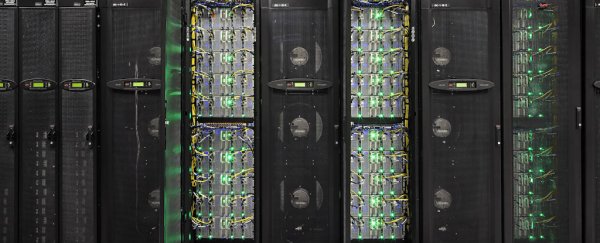If you thought advanced maths in high school was bad, spare a thought for a trio of mathematicians whose solution to a single maths problem takes up 200 terabytes of basic text - even with the help of a supercomputer.
When you consider that just 1 terabyte can hold 337,920 copies of War and Peace - one of the longest novels ever written - you can start to get a sense of just how insane that is. The previous record-holder was reportedly a 13-gigabyte proof, published in 2014.
So what's this ridiculous maths problem? It's been named the Boolean Pythagorean Triples problem, and was first posed by California-based mathematician Ronald Graham back in the 1980s.
The problem centres around the Pythagorean formula a2 + b2 = c2, where a and b are the shorter sides of a triangle, and c is the hypotenuse, or longest side.
Certain sets of three positive integers known as Pythagorean triples can be inserted into the formula, such as 32 + 42 = 52, 52 + 122 = 132, and 82 + 152 = 172.
With this in mind, imagine that every integer is painted either red or blue.
Graham asked if it's possible to colour all the integers either red or blue, so that no set of Pythagorean triples - a, b and c - were all the same colour. He put $100 on the line for anyone who could solve the problem. (That should cover a 1 terabyte drive.)
Andrew Moseman over at Popular Mechanics explains why that $100 looks mighty meagre, given the task ahead:
"What makes it so hard is that one integer can be part of multiple Pythagorean triples. Take 5. So 3, 4, and 5 are a Pythagorean triple. But so are 5, 12, and 13. If 5 is blue in the first example, then it has to be blue in the second, meaning either 12 or 13 has to be red.
Carry this logic forward into much bigger numbers and you could see where this would start to get tricky. If 12 has to be red in that 5-12-13 triple, it might force changes down the line that would result in a monochrome triple somewhere."
Mathematicians Marijn Heule from the University of Texas, Victor Marek from the University of Kentucky, and Oliver Kullmann from Swansea University in the UK teamed up to figure it out, feeding a number of different techniques into University of Texas's Stampede supercomputer and letting it narrow down the number of colour combination possibilities from 102,300 trillion (that's 102,300) to just 1 trillion.
The 800-processor-strong supercomputer then took two days to mull over the remaining trillion and come up with a solution: 7,824. As soon as you try 7,825 or more integers, you can't create the pattern Graham was looking for.
Guess who's now $100 richer… split three ways! Good guy Graham came through with the cheque earlier this month.
The proof, which in maths means a written deductive argument that shows how you came to your answer, takes up a 200-terabyte file on the supercomputer - roughly equivalent to all the digitised text held by the US Library of Congress.
According to Evelyn Lamb at Nature, the trio has created a 68-gigabyte compressed version of their solution, which would take about 30,000 hours to download, reconstruct and verify. The problem? No human could hope to read such a thing.
Instead, the team had to employ another computer program to verify the results, and show that their solution meets the criteria of the original question, and Graham was satisfied with the confirmation.
But critics are asking if this is enough. If no human can read the solution, that doesn't mean it's not correct, but it doesn't address one very important component of mathematical problem-solving - it can't explain why the colouring is impossible from 7,825 upwards, it just knows it is.
"Although the computer solution has cracked the Boolean Pythagorean triples problem, it hasn't provided an underlying reason why the colouring is impossible, or explored whether the number 7,825 is meaningful," Lamb explains. "That echoes a common philosophical objection to the value of computer-assisted proofs: they may be correct, but are they really mathematics?"
If mathematics is about advancing human knowledge and understanding what numbers mean to us and the Universe around us, a computer churning out solutions that we'll never understand seems to go against the very principles of the discipline.
As you ponder that question, you can take a look at the paper on pre-print website, arXiv.org. It hasn't been peer-reviewed yet, because, well, we'd need a team of maths robots for that, I guess.
